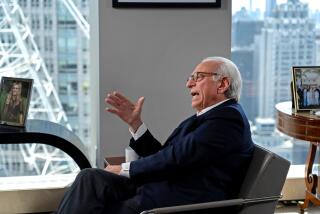No Fairy Tale : Stock Market Teaches Children’s Wonderland a Painful Lesson
- Share via
The owners of Children’s Wonderland might find “Nightmareland” a more apt name for their Agoura Hills firm these days.
The once highly touted operator of day-care centers that cater to both children and the elderly has seen its stock price plummet nearly 100% since it went public almost exactly a year ago.
Last month, Children’s was thrown off Nasdaq for being undercapitalized, and the company’s president abruptly resigned after four months on the job, without giving a reason.
If that wasn’t enough, in early May one of the company’s underwriters, bogged down by its own financial woes, stopped dealing in the company’s stock. Shares of Children’s Wonderland fell as low as 2 cents--from an initial offering price of $4--though they have recovered somewhat and closed Wednesday at $1.16 in over-the-counter trading.
“I feel Children’s Wonderland has become the victim of something ugly outside,” said Debby Bitticks, the company’s 52-year-old founder and CEO. “We are doing a full investigation. We are the same business we were before, and nothing we did had anything to do with that drop in stock price.”
Others say it’s hardly surprising that the firm, badly bleeding red ink and lacking capital, would see its shares plunge--especially in the depressed small-stock market of March and April.
Bitticks stresses that despite the stock problems, it’s business as usual among the company’s 300 employees and its 14 centers, including those in Lake Forest, Oxnard and Woodland Hills.
On Wednesday, her company filed suit in U.S. District Court against the two investment banking firms and some of the principals there that helped Children’s Wonderland sell stock on Wall Street. The suit, claiming more than $10 million in damages, alleges fraud and breach of fiduciary duty.
Whether those allegations are true remains to be seen. From one view, Children’s Wonderland can be seen as a classic example of a fast-growing, but unprofitable, company whose stock is highly speculative and volatile and thus suitable only for investors willing to take huge risks.
But Bitticks believes the firm’s woes stem from poor decisions related to how it made its initial public offering of stock.
“If I had to do it all again, I would’ve gone public, but never with the same underwriters,” she said. “Every company thinking of selling stock should check out their underwriters. Or, heaven forbid, they’ll be where we are now.”
In its suit, Children’s contends that its lead underwriter threatened to withdraw support for the stock and undermine the offering if the company “elected to do business with any other . . . investment bankers.” Children’s also contends that the underwriter made “fraudulent promises” about its “ability and inclination to raise capital” for the firm.
The lead underwriter, Royce Investment Group in Long Island, and its co-manager, First Cambridge Securities of New York, would not comment. But they have blamed the stock’s problems on “short sellers,” traders who profit when a company’s share price falls, the suit alleges.
Like many companies, Children’s took advantage of a record year for IPOs last year when it decided to go public. And like some other Southern California companies, such as Irvine-based fashion designer Mossimo Inc. and Mission Viejo-based Chicago Pizza & Brewery, its stock is now trading far below its initial offering price.
Started in 1993 by Bitticks and her husband, Kenneth, a former CPA, Children’s Wonderland developed a program to deal with a problem facing many working baby boomers: how to manage day care for elderly parents and young children.
Because of a natural affinity between the very young and very old, the couple attempted to put the two groups together as part of “intergenerational” day-care programs, similar to ones already successful in Europe. The bulk of Children’s centers are in California and Colorado, with several on the East Coast.
At the company’s Oxnard center, the elderly pay an average of $200 a week, which includes nine hours of crafts and games and a hot lunch. The fee for children is about $125 a week.
The biggest obstacle for a company developing a string of intergenerational centers is finding enough initial capital, specialists said. In fact, when Children’s went public it already had an accumulated loss of $5.4 million due to expansion and start-up costs, company documents show.
“There are considerable upfront expenses with these types of centers,” said Judith Leavitt, executive director of Generations United, a Washington nonprofit that specializes in intergenerational issues.
“You need a lot of facilities that will meet codes for both elderly and children, and you need a lot of staff. It’s a wonderful idea, but so far not a big moneymaker for anyone yet,” she said.
Children’s once touted ambitious plans to become a national powerhouse and grow its 14 centers into 77 day-care centers nationwide. And in its first day of trading, the company saw its stock more than double to $10.75 a share, due to high investor demand.
Children’s now is fighting to regain its financial footing. For help, the beleaguered company has hired Century City image makers Sitrick & Co. It has also retained Ambient Capital Group Inc., a boutique Los Angeles investment banking firm.
“Their capital right now is nothing to write home about, but at least they are not under any pressure from their creditors,” said James D. Somes, a managing director at Ambient.
Like many young, fast-growing companies, Children’s Wonderland has yet to post an annual profit. In its most recent reporting quarter, Children’s saw its revenue increase 15.9% to $1.26 million at the end of December, from the same time last year. It reported a loss of $1.32 million, or 34 cents a share.
To grow her business and increase the number of centers, Bitticks, a former educational therapist who opened her first day-care center in 1972, opted to raise capital by selling stock in her company to the public. The Bitticks then hired Royce Investment Group and First Cambridge.
The investment bankers helped Children’s Wonderland raise $5.7 million by selling 1.7 million shares to mostly smaller, individual investors. About 15% of those funds were used to pay down about $900,000 of debt, and the rest was earmarked for expansion and working capital.
Underwriters then promised the company they would raise another $3 million through private sources to help it grow. That growth was something shareholders were betting on, but the additional money never materialized.
John Marciano, president of Royce Investments, would not return phone calls. At First Cambridge, Seth Margoshes, an analyst who follows Children’s, would not talk publicly.
But in the last few weeks, First Cambridge has stopped being what is called a “market maker” in Children’s Wonderland stock, which means it trades or buys a company’s stock if there is a demand, said Michael Robinson, a spokesman for the National Assn. of Securities Dealers. First Cambridge doesn’t have enough capital to be a broker-dealer under NASD rules, sources said.
One theory is that short sellers are responsible for both Children’s and First Cambridge’s woes. In a short sale, a trader borrows stock and sells it in the open market. If the price plunges, as the trader expects, the trader can buy shares at a cheaper price and repay the loaned shares--thus profiting.
Once Children’s extra funding didn’t come through, the theory goes, shorts seized an opportunity to gang up on the stock via heavy short selling.
“We were put out of business by the fight we put up against the short sellers to save Children’s Wonderland,” a First Cambridge source said. “We are no longer a broker-dealer. Our management has begun to entertain other proposals to get us back on track.”
Indeed, according to data provided by the NASD, the number of Children’s shares sold short rose dramatically in January to 146,262 shares, compared to 55,950 shares in November. In April, 87,650 shares were shorted, the firm said.
While short sellers may have been a factor, others just see Children’s as a typical hot stock gone cold.
Brian Fitzpatrick, president of Children’s from 1993 to 1995, said he thinks day-care companies in general are just hard to run.
“The concept is great, but like any early-stage company, there’s what you want to be and what it will take to get there,” said Fitzpatrick.
Michael Laney, a former Warner Bros. executive who was the company’s most recent president, resigned in April. He would not comment for this story.
Some of the company’s problems stemmed from published reports in Denver of a 3-month-old boy left alone in a Children’s Wonderland day-care center when employees locked up at 6 p.m.
A supervisor, who was later fired, did not see the child sleeping under a blanket in a crib. Police broke into the center around 8 p.m. after receiving frantic calls from the parents, who realized no one had picked up the child. That frightened institutional investors interested in investing more money in the company after it went public, said sources close to the company.
“I don’t think that’s true,” said Bitticks. “We took those Denver centers out of bankruptcy, and we were trying to bring them up to our standards. We have a very clean reputation.”
Despite the stock woes, the Bittickses say the company’s problems will not impede current plans for a children’s sports and adventure camp this summer in Agoura.
“We are very excited about what we are trying to do here,” she said. “The workings of the stock market--I’ve just never understood them.”
(BEGIN TEXT OF INFOBOX / INFOGRAPHIC)
Jack Fell Down
Children’s Wonderland went public May 6, 1996, at $4 per share and raised $5.7 million. But in April, the stock was delisted from Nasdaq. It continues to trade on the over-the-counter market. Monthly closes and latest:
Wednesday: $1.16, up 9 cents
Source: Bloomberg News
More to Read
Inside the business of entertainment
The Wide Shot brings you news, analysis and insights on everything from streaming wars to production — and what it all means for the future.
You may occasionally receive promotional content from the Los Angeles Times.










